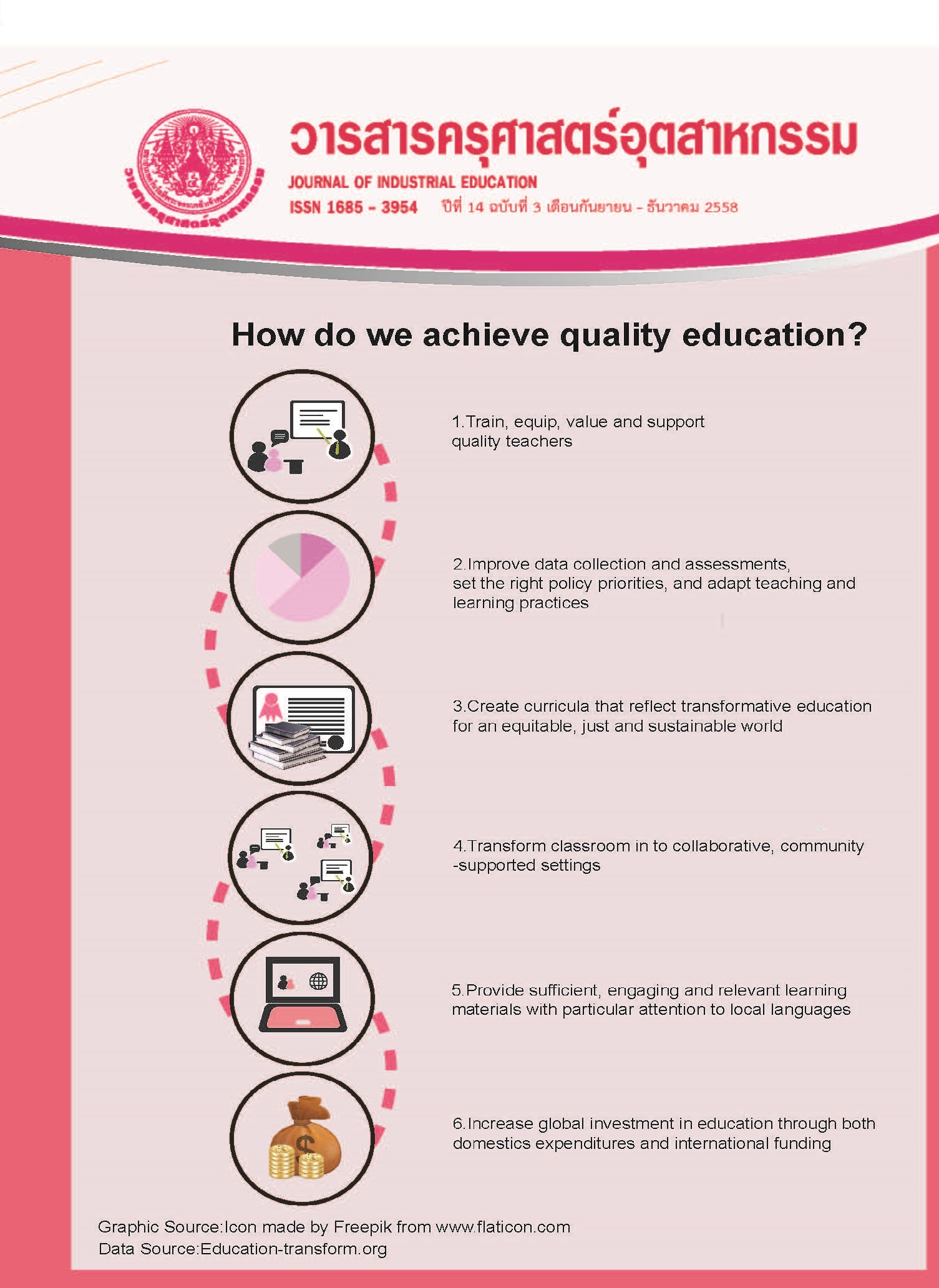Effect of Problem-Based E-Learning Courseware on Achievement in the Course of Creating Works with Computer for Mathayomsuksa 4 Students
Keywords:
Problem-based learning, E-learning courseware, efficiency, learning achievement, Array and String VariablesAbstract
The objectives of the study were 1) to develop the problem-based e-learning courseware for the course of Creating Works with Computer on the learning topic of Array and String Variables on quality and efficiency and 2) to compare learning achievement between the students learning with the courseware and those learning with conventional method. The sample of the study comprised Mathayomsuksa 4 students in 3 classrooms at Suankularb Wittayalai School in the second semester of the academic year 2014, selected by cluster random sampling method. The research instruments included a problem-based e-learning courseware for the course of Creating Works with Computer on the learning topic of Array and String Variables, a courseware quality evaluation form and an achievement test. The data were analyzed by using arithmetic mean, standard deviation and t-test for independent sample. The results showed that:
1. Content quality (=4.57, S.D.=0.32) and media production quality (
=4.67, S.D.=0.47) of the courseware were at an excellent level,
2. Efficiency E1:E2 of the courseware was at 80.86: 83.11,
3. Learning achievement on Array and String Variables of the students who learned with the developed courseware was significantly higher than the students who learned with conventional method at .05.
References
[2] อรุณรุ่ง ปภาพสิษฐ. Problem-Based Learning: การเรียนที่ใช้เป็นปัญหาเป็นหลัก. ค้นเมื่อวันที่ 12 มีนาคม 2558,จากhttps://www.pnru.ac.th/fac/tedu/upload-files/uploadfile/29/6e682264abd39e8c64b39960ff4c2a0b.pdf
[3] ศิริรัตน์ เพ็ชร์แสงศรี. 2555.การเรียนแบบผสมผสาน และการประยุกต์ใช้.วารสารครุศาสตร์อุตสาหกรรม, 11(1) , น.2.
[4] Seels, B. and Glasgow, Z. 1998. Making Instructional Design Decisions. (2nd ed.). Columbus, Ohio : Prentice-Haii.
[5] ชัยยงค์ พรหมวงศ์. 2520. ระบบสื่อการสอน.กรุงเทพฯ : จุฬาลงกรมหาวิทยาลัย.
[6] ทิศนา แขมมณี. 2555. ศาสตร์การสอน.กรุงเทพฯ :สำนักพิมพ์แห่งจุฬาลงกรณ์มหาวิทยาลัย.
[7] นพดล จักรแก้ว. 2556.การพัฒนาบทเรียนผ่านระบบเครือข่ายอินเทอร์เน็ตเพื่อการทบทวน เรื่อง ภาษาซี วิชา การเขียนโปรแกรมเชิงโครงสร้าง.วารสารครุศาสตร์อุตสาหกรรม, 12(2), น.32-37.
[8] อุมาพร ต้อยแก้ว. 2554.การพัฒนาบทเรียนออนไลน์โดยใช้เทคนิคการเรียนรู้แบบปัญหาเป็นฐานเพื่อพัฒนาทักษะการคิดวิเคราะห์ วิชาการเขียนโปรแกรมภาษาซี สำหรับนักเรียนชั้นมัธยมศึกษาปีที่ 5.วิทยานิพนธ์ปริญญาครุศาสตร์อุตสาหกรรมมหาบัณฑิต คณะครุศาสตร์อุตสาหกรรม มหาวิทยาลัยเทคโนโลยีพระจอมเกล้าธนบุรี.
[9] วัชราภรณ์ วังมนตรี. 2552.การพัฒนาบทเรียนออนไลน์โดยใช้เทคนิคปัญหาเป็นฐาน วิชาการเขียนโปรแกรมภาษาซี หลักสูตรระดับประกาศนียบัตรวิชาชีพชั้นสูง.วิทยานิพนธ์ปริญญาครุศาสตร์อุตสาหกรรมมหาบัณฑิต คณะครุศาสตร์อุตสาหกรรม มหาวิทยาลัยเทคโนโลยีพระจอมเกล้าพระนครเหนือ
Downloads
Published
How to Cite
Issue
Section
License
"The opinions and contents including the words in papers are responsibility by the authors."
"ข้อคิดเห็น เนื้อหา รวมทั้งการใช้ภาษาในบทความถือเป็นความรับผิดชอบของผู้เขียน"



